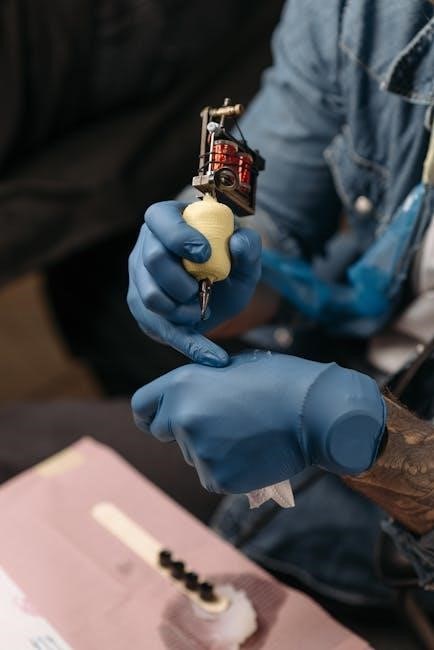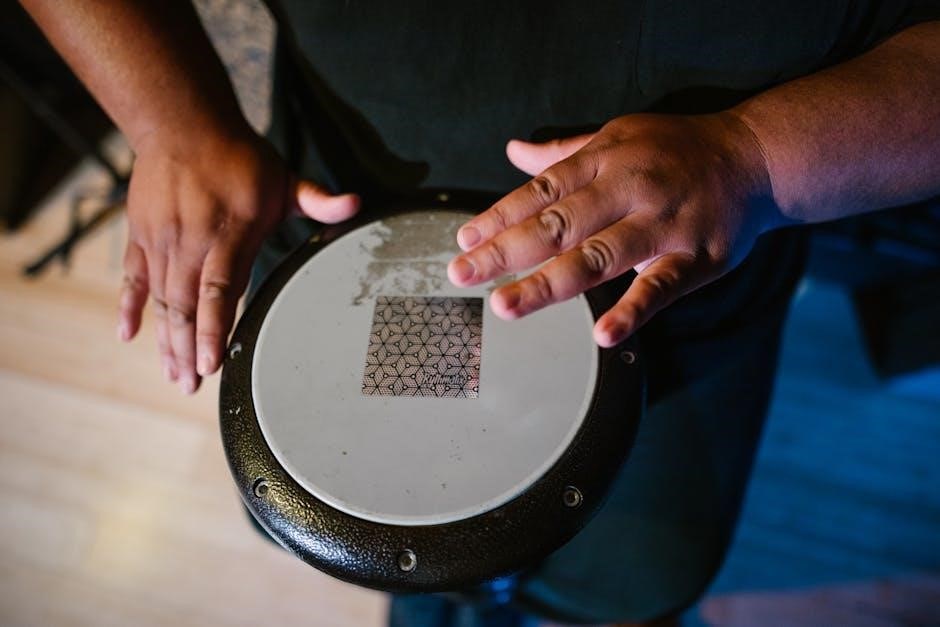The TH350 manual valve body is a popular aftermarket component designed for the GM TH350 automatic transmission. It replaces the stock valve body‚ offering enhanced control over gear shifts. This upgrade is ideal for high-performance‚ racing‚ or heavy-duty applications. By eliminating the reliance on the transmission’s vacuum modulator‚ it provides precise manual shifting. The manual valve body is prized for its durability‚ reliability‚ and ability to withstand rigorous driving conditions. It’s a key modification for those seeking improved transmission performance.

History of the TH350
The TH350‚ also known as the Turbo Hydra-Matic 350‚ is a three-speed automatic transmission developed by General Motors (GM). Introduced in the early 1970s‚ it quickly became one of the most popular and widely used transmissions in GM vehicles. The TH350 was designed to replace the earlier two-speed automatic transmissions‚ offering improved performance‚ fuel efficiency‚ and reliability. Its compact design made it versatile‚ suitable for a wide range of vehicles‚ from small cars to trucks and SUVs.
The TH350 was a significant advancement in transmission technology at the time. It featured a lightweight aluminum alloy case‚ which reduced overall vehicle weight while maintaining strength. The transmission was also equipped with a lock-up torque converter‚ which improved fuel efficiency by reducing slippage during highway driving. These innovations made the TH350 a favorite among both everyday drivers and racing enthusiasts.
During its production run‚ the TH350 underwent several updates to address evolving automotive standards. For instance‚ in the late 1970s‚ GM introduced a “lock-up” version of the TH350‚ which further enhanced performance and efficiency. However‚ by the late 1980s‚ the TH350 began to be phased out in favor of more modern transmissions like the 700R4 (later renamed 4L60E)‚ which offered better fuel economy and smoother shifting.
Despite being discontinued‚ the TH350 gained a cult following among car enthusiasts and rebuilders. Its simplicity‚ durability‚ and adaptability made it a popular choice for custom builds and high-performance applications. The introduction of aftermarket components‚ such as the manual valve body‚ further extended its lifespan and versatility. Today‚ the TH350 remains a staple in classic car restoration and performance upgrades‚ a testament to its enduring legacy in automotive history.
The TH350’s history is a reflection of GM’s commitment to innovation and performance. From its humble beginnings as a replacement for outdated transmissions to its modern-day popularity in the aftermarket scene‚ the TH350 has left an indelible mark on the automotive world.

Components of the Manual Valve Body
The manual valve body for the TH350 transmission is a sophisticated component designed to provide precise control over gear shifts. Unlike the stock automatic valve body‚ which relies on hydraulic pressure and electronic controls‚ the manual version is streamlined for direct driver input. The key components of the manual valve body include:
- Manual Shift Mechanism: This is the core of the system‚ allowing the driver to manually select gears using a shifter. It eliminates the need for an automatic gear selector.
- Valve Body Housing: Made from durable materials like aluminum or steel‚ this housing contains the internal components and directs hydraulic fluid flow.
- Shift Forks and Rails: These components engage and disengage gears based on the driver’s input. They are designed for quick‚ precise shifts.
- Hydraulic Solenoids: In some configurations‚ solenoids are used to control hydraulic pressure‚ ensuring smooth transitions between gears.
- Accumulator: This component regulates hydraulic pressure‚ preventing sudden shifts or harsh engagements.
- Valve Piston and Springs: These regulate fluid flow within the valve body‚ ensuring proper engagement and disengagement of clutches and bands.
- Seals and Gaskets: Essential for preventing fluid leaks and maintaining consistent hydraulic pressure.
- Torque Converter Clutch Solenoid: In some setups‚ this solenoid controls the lock-up torque converter for improved fuel efficiency and performance.
- Mounting Hardware: Includes bolts‚ studs‚ and gaskets to secure the valve body to the transmission case.
Each component is carefully engineered to work in harmony‚ providing drivers with a more engaging and controlled driving experience. The manual valve body is a significant upgrade for enthusiasts seeking improved performance and reliability.
These components are designed to withstand the rigors of high-performance driving‚ making the manual valve body a popular choice for racing‚ towing‚ or heavy-duty applications.

Automatic vs. Manual Valve Body
The TH350 transmission is traditionally equipped with an automatic valve body‚ designed to provide smooth‚ hands-free shifting. However‚ the manual valve body offers a different approach‚ catering to drivers who prefer more control over gear changes. Understanding the differences between these two systems is crucial for deciding which setup best suits your needs.
Automatic Valve Body
The automatic valve body relies on hydraulic pressure and electronic controls to manage gear shifts. It uses sensors and actuators to determine when to shift based on factors like throttle position‚ vehicle speed‚ and engine load. This system is ideal for everyday driving‚ as it requires minimal driver input and provides seamless transitions between gears.
Manual Valve Body
In contrast‚ the manual valve body eliminates the need for electronic controls and hydraulic automation. Instead‚ it allows the driver to manually select gears using a shifter‚ similar to a manual transmission. This setup is favored by enthusiasts and those who demand precise control‚ especially in high-performance or racing environments.
Key Differences
- Control: The automatic valve body offers convenience and ease of use‚ while the manual version provides direct driver control over gear shifts.
- Performance: Manual valve bodies are often preferred for their responsiveness and ability to handle high-stress conditions.
- Reliability: Both systems are durable‚ but manual configurations may require more maintenance due to the elimination of automatic features.
- Installation: The manual valve body typically requires additional components‚ such as a shifter and linkage‚ for proper operation.
Choosing between an automatic and manual valve body depends on your driving habits and preferences. The automatic system is perfect for everyday use‚ while the manual option is ideal for those seeking enhanced performance and control.

Installation Guide
Installing a manual valve body in your TH350 transmission requires careful planning and execution. This guide will walk you through the key steps to ensure a successful installation.
Preparation
- Gather all necessary tools‚ including a transmission pan gasket‚ filter‚ and new fluid.
- Drain the transmission fluid and remove the pan to access the valve body.
- Disconnect the throttle valve cable and electrical connectors from the automatic valve body.
Removal of the Automatic Valve Body
- Locate the valve body bolts and remove them carefully.
- Gently pull the valve body out of the transmission case.
- Inspect the area for any debris or old gasket material and clean thoroughly.
Installing the Manual Valve Body
- Apply a thin layer of transmission sealant to the new valve body’s gasket.
- Align the manual valve body with the transmission case and secure it using the provided bolts.
- Tighten the bolts in a star pattern to avoid warping the valve body housing.
Reassembly and Testing
- Reattach the throttle valve cable and electrical connectors to the manual valve body.
- Replace the transmission pan and filter‚ then refill the fluid to the recommended level.
- Test the transmission by manually shifting through all gears to ensure proper engagement.
Important Considerations
- Consult a professional if you’re unsure about any step.
- Use high-quality transmission fluid compatible with your TH350.
- Double-check all connections and bolts before driving.
By following these steps‚ you can successfully install a manual valve body in your TH350 transmission‚ unlocking enhanced control and performance.

Maintenance and Care
Proper maintenance and care are essential to ensure the longevity and optimal performance of your TH350 manual valve body. Regular inspections and timely adjustments can prevent costly repairs and ensure smooth transmission operation.
Fluid Checks and Changes
- Check the transmission fluid level regularly‚ using the dipstick provided.
- Replace the fluid every 30‚000 to 60‚000 miles‚ depending on usage and driving conditions.
- Use high-quality transmission fluid specifically designed for the TH350.
Filter Maintenance
- Inspect and replace the transmission filter every 15‚000 to 30‚000 miles.
- Clean or replace the filter if it becomes clogged with debris.
Valve Body Inspection
- Periodically inspect the manual valve body for signs of wear or damage.
- Check for any leaks around the gaskets and seals.
- Clean the valve body and surrounding areas to prevent contamination.
Shift Cable Adjustment
- Adjust the shift cable periodically to ensure proper engagement of gears.
- Refer to your manual for specific adjustment procedures.
Preventative Measures
- Avoid extreme temperatures and heavy loads without proper cooling.
- Use the correct tools when working on the transmission to prevent damage.
- Keep the transmission pan clean and free of debris.
By adhering to these maintenance and care tips‚ you can extend the life of your TH350 manual valve body and ensure it continues to perform at its best. Regular attention to these details will help prevent issues and keep your transmission running smoothly for years to come.

Troubleshooting Common Issues
Like any transmission component‚ the TH350 manual valve body can experience issues over time. Identifying and addressing these problems early is crucial to maintaining optimal performance. Below are some common issues and their potential solutions.
Delayed or Harsh Shifting
- Cause: Worn or damaged shift valves‚ or incorrect adjustment of the manual valve body.
- Solution: Inspect the shift valves for wear and replace them if necessary. Adjust the valve body according to the manufacturer’s specifications.
Transmission Leaks
- Cause: Damaged gaskets‚ seals‚ or pan gasket failure.
- Solution: Inspect the valve body and transmission pan for signs of leaks. Replace any damaged gaskets or seals and ensure all connections are tight.
Slipping Gears
- Cause: Worn clutch packs‚ bands‚ or low transmission fluid levels.
- Solution: Check the transmission fluid level and top it off if necessary. Inspect the clutch packs and bands for wear and replace them if needed.
No Engagement When Shifting
- Cause: Faulty shift cable‚ misaligned valve body‚ or electrical issues (if equipped with electronic controls).
- Solution: Check the shift cable for damage or misalignment. Ensure the valve body is properly installed and aligned. Test electrical connections if applicable.
Overheating Transmission
- Cause: Insufficient cooling‚ excessive load‚ or blocked transmission cooler lines.
- Solution: Ensure proper cooling by checking the transmission cooler and lines. Reduce the load or install an aftermarket cooler if necessary.
Worn Valve Body Components
- Cause: Prolonged use without maintenance or exposure to contaminants.
- Solution: Regularly inspect and clean the valve body. Replace any worn or damaged components promptly.
By addressing these common issues promptly‚ you can prevent further damage to your TH350 manual valve body and ensure smooth‚ reliable performance. Always refer to your manual or consult a professional if you’re unsure about any repairs.

Upgrading and Performance Enhancement
Upgrading the TH350 manual valve body is a popular choice for enthusiasts seeking improved performance‚ reliability‚ and control. Whether for racing‚ towing‚ or high-performance driving‚ several modifications can enhance the transmission’s capabilities. These upgrades not only optimize gear shifting but also ensure the transmission can handle increased power and stress.
High-Performance Shift Kits
- Installing a high-performance shift kit is one of the most common upgrades for the TH350.
- These kits typically include reinforced springs‚ improved solenoids‚ and modified valve components.
- The result is faster and firmer shifts‚ reducing slippage and improving overall responsiveness.
- This upgrade is particularly beneficial for racing or heavy-duty applications where quick‚ precise shifts are critical.
Valve Body Porting and Polishing
- Porting and polishing the valve body can improve fluid flow and reduce turbulence.
- This modification enhances the transmission’s efficiency‚ particularly during high-RPM operations.
- Professional machining is recommended to ensure precise results and avoid damage to critical components.
Upgraded Clutch Packs and Bands
- Replacing the stock clutch packs and bands with high-performance alternatives can significantly improve durability.
- These components are designed to withstand higher torque and heat‚ reducing the risk of slippage and wear.
- Upgraded clutch packs are especially important for vehicles subjected to heavy loads or frequent acceleration.
Manual Valve Body Enhancements
- The manual valve body itself can be further enhanced with aftermarket components.
- Upgraded shift valves‚ improved sealing‚ and reinforced construction can provide even better control and reliability.
- These modifications are particularly favored by drag racers and performance enthusiasts.
Cooling System Upgrades
- Enhancing the transmission’s cooling system is essential for maintaining performance during prolonged use.
- Installing a high-capacity transmission cooler and ensuring proper fluid circulation can prevent overheating.
- Regular fluid changes with high-performance transmission fluid are also recommended.
Electronic Controls and Adjustments
- For advanced users‚ electronic controllers can be integrated to fine-tune shift points and pressure.
- This allows for customized performance based on specific driving conditions or power levels.
- However‚ this level of modification typically requires specialized knowledge and tools.
By implementing these upgrades‚ the TH350 manual valve body can deliver exceptional performance and durability. Whether on the track or the street‚ these modifications ensure the transmission can handle increased power and deliver smooth‚ precise shifts. Always consult a professional or follow detailed instructions to avoid complications during the upgrade process.

Cost Considerations
When considering the installation of a TH350 manual valve body‚ it’s essential to evaluate the associated costs to ensure the project aligns with your budget. The total expense will depend on several factors‚ including the quality of the components‚ labor costs‚ and whether additional upgrades are required. Below is a breakdown of the typical costs involved.
Cost of the Manual Valve Body
- A high-quality TH350 manual valve body typically ranges in price from $500 to $1‚200‚ depending on the brand and features.
- Premium options with advanced components‚ such as billet construction or improved shift valves‚ may cost closer to $1‚500 or more.
- Used or refurbished units can be found for $300 to $600 but may require additional inspections or repairs.
Installation Costs
- Professional installation by a qualified transmission specialist can range from $500 to $1‚000‚ depending on the shop’s labor rates and location.
- DIY installation is possible for experienced enthusiasts but requires specialized tools and knowledge to avoid costly mistakes.
- Additional labor costs may apply if the transmission requires disassembly or if other components need replacement.
Additional Components
- Upgrading to a manual valve body often requires additional parts‚ such as a new shift kit‚ clutch packs‚ or sealing rings‚ which can add $200 to $500 to the total cost.
- High-performance transmission fluid and filters may also be necessary‚ costing around $50 to $100.
- Cooling system upgrades‚ such as a high-capacity transmission cooler‚ can add another $100 to $300.
Long-Term Maintenance
- While the manual valve body is designed for durability‚ regular maintenance is still required to ensure optimal performance.
- Transmission fluid changes‚ filter replacements‚ and inspections can cost $100 to $300 annually‚ depending on usage.
- Over time‚ these costs can add up‚ but they are generally lower than the maintenance required for a stock valve body in high-performance applications.
Total Estimated Cost
- For a basic setup with a mid-range manual valve body and professional installation‚ expect to spend around $1‚200 to $2‚000.
- High-performance builds with premium components and additional upgrades can range from $2‚500 to $4‚000 or more.
- DIY projects can save on labor costs but may require a larger upfront investment in tools and components.
While the initial cost and installation process may seem daunting‚ the long-term benefits of improved transmission control and reduced wear on internal components make it a smart choice for serious drivers. Whether you’re building a race car‚ a tow vehicle‚ or a street machine‚ the TH350 manual valve body delivers the responsiveness and consistency that stock systems often lack. With proper installation and maintenance‚ it can provide years of trouble-free service and elevate your vehicle’s performance to the next level.
For those considering this upgrade‚ it’s important to weigh the costs and labor requirements against the desired outcomes. However‚ for anyone looking to maximize their transmission’s potential‚ the TH350 manual valve body is a proven and effective solution. Its ability to handle extreme conditions while maintaining smooth‚ precise shifts makes it a favorite among transmission enthusiasts. In short‚ the TH350 manual valve body is a reliable and high-performance upgrade that delivers exceptional results for drivers who demand the best.

FAQ and Common Queries
What is a TH350 manual valve body?
A TH350 manual valve body is an aftermarket component designed to replace the stock valve body in GM TH350 automatic transmissions. It allows for manual control over gear shifts‚ eliminating the need for the vacuum modulator.
What are the benefits of a manual valve body over the stock automatic?
The manual valve body provides precise control over shifts‚ improved performance‚ and reduced wear on transmission components. It is ideal for high-performance‚ racing‚ or heavy-duty applications.
Is the TH350 manual valve body suitable for my vehicle?
The TH350 manual valve body is compatible with vehicles equipped with the GM TH350 transmission. It is highly recommended for drivers seeking enhanced control and performance.
Do I need special skills to install a TH350 manual valve body?
Installation requires mechanical knowledge and transmission repair experience. It is recommended to have a professional perform the job if you are not familiar with transmission internals.
Will a manual valve body make my transmission harder to drive?
The manual valve body requires manual shifting‚ which can take some time to get used to. However‚ it offers better control and performance‚ especially in high-stress driving conditions.
What are the main advantages of a manual valve body?
The manual valve body provides faster and more precise shifts‚ reduced slippage‚ and improved durability. It is designed to handle the demands of performance driving.
Can I reuse my existing transmission fluid with a manual valve body?
Yes‚ the manual valve body works with the same transmission fluid as the stock unit. However‚ it is recommended to use high-quality fluid to ensure optimal performance.
How much does a TH350 manual valve body cost?
The cost varies depending on the manufacturer and quality. Expect to pay between $300 and $800 for a high-quality manual valve body.
Is the TH350 manual valve body worth the investment?
For drivers seeking enhanced performance and control‚ the manual valve body is a worthwhile upgrade. It offers improved reliability and durability compared to the stock unit.
Can I install a manual valve body myself?
While possible‚ it is highly recommended to have a professional install the manual valve body to ensure proper function and avoid costly repairs.
How do I maintain my TH350 manual valve body?
Regular fluid changes and inspections are essential. Proper care will extend the life of the manual valve body and ensure optimal performance.
Is the TH350 manual valve body reliable?
Yes‚ the manual valve body is known for its reliability and durability. It is designed to withstand the rigors of performance driving.
Can I use a manual valve body for daily driving?
While possible‚ the manual valve body is primarily designed for performance applications. Daily driving may require adjustments to shifting techniques.
Does the manual valve body come with a warranty?
Most manufacturers offer a warranty on their manual valve bodies. Be sure to check the terms and conditions before purchasing.
How long does installation typically take?
Installation can take several hours‚ depending on the complexity of the job and the installer’s experience. Plan accordingly and budget for labor costs.

